Does Bioavailability Change Between Animal And Plant Sources?
 Found-based diets are condign increasingly popular, but not all sources of nutrients are the aforementioned. Animal-based foods like milk or meat are rich sources of certain essential nutrients that are easily absorbed by the human body. These same nutrients are present in many plants but tin can sometimes exist less bachelor to the human being trunk to digest and absorb. Therefore, food bioavailability must be considered when consuming a plant-based diet. Many factors can affect nutrient bioavailability such equally anti-nutrients[1] like oxalates, phytates, and tannins; cooking and processing methods; and factors in the human body
Found-based diets are condign increasingly popular, but not all sources of nutrients are the aforementioned. Animal-based foods like milk or meat are rich sources of certain essential nutrients that are easily absorbed by the human body. These same nutrients are present in many plants but tin can sometimes exist less bachelor to the human being trunk to digest and absorb. Therefore, food bioavailability must be considered when consuming a plant-based diet. Many factors can affect nutrient bioavailability such equally anti-nutrients[1] like oxalates, phytates, and tannins; cooking and processing methods; and factors in the human body
This science review looks at:
- Nutrients unremarkably under-consumed from a plant-based nutrition, and how to increase intake of those nutrients from plants
- Which nutrients are less bioavailable from plant-based foods
- How bioavailability can exist improved by cooking and processing
The nutrients of special concern in establish-based diets are (click to jump to that nutrient on the page):
- Calcium
- Protein
- Vitamin D
- Fe
- Zinc
- Vitamin B12
- Vitamin A
- Omega-iii fats/a-linoleic acid
- Iodine
What does bioavailability hateful?
The European Food Information Council (EUFIC) defines bioavailability every bit "the proportion of a nutrient that is absorbed from the diet and used for normal body functions"[ii]. Everything food that is eaten needs to exist digested and captivated in the intestine, and the presence of some compounds in plants can brand that process more difficult for the trunk. For case, antinutrients can block digestive enzymes from reaching parts of a food to be digested. Oxalic acid is a molecule that plants produce to demark actress calcium inside the plant. This molecule helps the plant part properly, merely it too means that when nosotros swallow the plant, the calcium is harder for the human body to digest and absorb. In this example, the calcium would have a low bioavailability.

Cooking can increase the bioavailability of many nutrients from plants.
Calcium
Found-based calcium sources
Institute sources that are naturally rich in bioavailable calcium are express[3],[four]. Ordinarily recommended plant sources of calcium include kale, legumes, figs, bok choy, and broccoli. Nevertheless, the quantity and bioavailability of calcium within these foods is far lower than dairy products or calcium fortified foods[5],[vi]. For example, the EPIC-Oxford cohort observed that vegans had inadequate intakes of calcium, approximately half the mean intake level of non-vegetarians[7]. The presence of oxalic acid, or oxalate, reduces calcium bioavailability[viii]. Oxalic acid, which is present in many calcium rich institute foods, particularly leafy vegetables[9], binds to calcium to form oxalate, which is not very well absorbed across the gut[x].
Spinach is a renowned instance of a food high in calcium, yet absorption is very depression due to the oxalate content. Turnip greens have a similar calcium level but lower oxalate content, thus absorption is significantly higher than from spinach[11]. Grains and legumes, which in general make upwards a substantial part of a plant-based diet, are high in phytates, which demark calcium strongly and these complexes are insoluble in the small intestine, making them hard to assimilate and absorb. Information technology is estimated that 32% of calcium from dairy-based foods is captivated, but only 5% of calcium from spinach is absorbed.
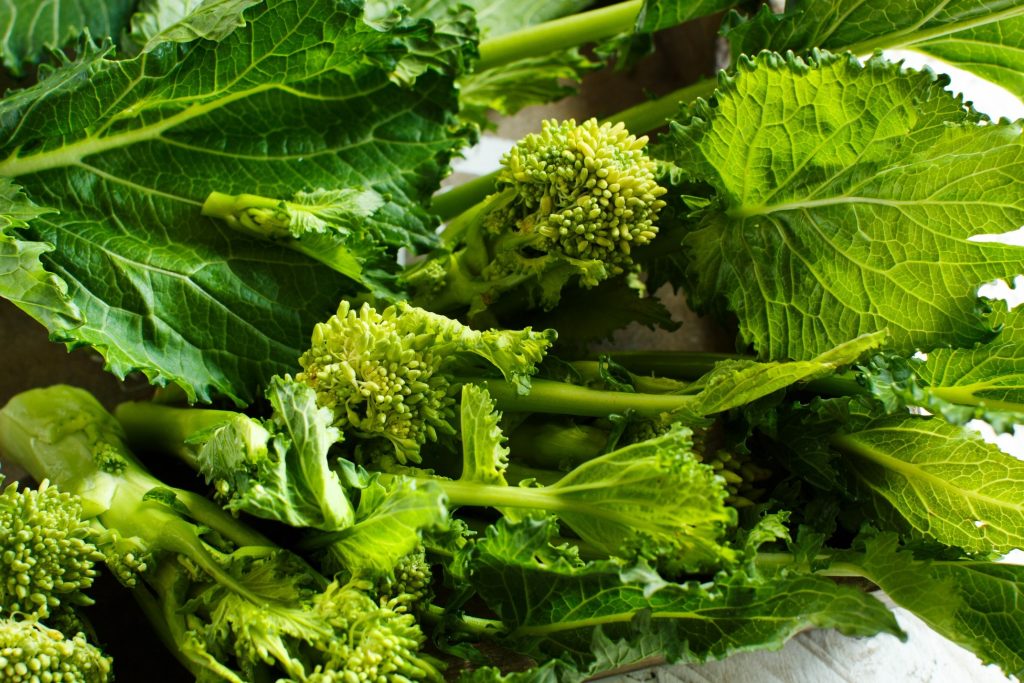
Turnip greens take a lower oxalate content than spinach, making the calcium from turnip greens more than bioavailable.
| Become KHNI articles delivered to your inbox |
Improving bioavailability of plant-based calcium
Studies have shown reducing phytates levels significantly increases calcium absorption from grains, pulses and legumes[12],[13]. Tannins and fibre tin can also negatively touch on calcium bioavailability. In vitro tests take shown that germinating and de-hulling cowpeas, lentils or chickpeas to reduce tannin and fibre levels can significantly increase calcium bioavailability[14].
Factors in the human being trunk can also influence calcium bioavailability. Calcium is absorbed beyond the gut past vitamin D dependent agile transport and facilitated diffusion. Therefore, an private's vitamin D levels tin affect calcium absorption. Factors such equally sex, age, and individual calcium stores bear upon the charge per unit of facilitated diffusion. The lower a person'due south calcium stores, the more the gut volition blot this nutrient, only this power decreases with age[fifteen].
To summarise, bioavailability of calcium in a plant-based diet is not optimum mainly due to the quantity and presence of innate inhibitors. Cooking or processing plants to remove antinutrients tin better bioavailability, and some constitute-based sources of calcium are more than bioavailable than others. However, it is commonly suggested that people who do not consume animal products, particularly dairy, should eat foods fortified with calcium or take a calcium and vitamin D supplement to meet the recommended daily allowance (RDA) for this mineral[16],[17].
Protein
Differences between found-based poly peptide and animal-based poly peptide
The most obvious business concern regarding protein in plant-based diets is that sources are mostly limited in one or more essential amino acids that cannot be made past the human body. Therefore, plant-sourced proteins are oft referred to as 'incomplete'. This is contrary to animal derived protein sources, which incorporate consummate combinations of essential amino acids. The most common limited essential amino acids in plant-based diets are lysine (mainly limited in cereals), methionine (legumes, nuts and seeds), tryptophan (cereals) and cysteine (legumes)[eighteen].
Poly peptide complementation
Protein complementation, the combination of vegetable proteins to get all of the amino acids that are essential for the body, is the nearly effective way to meet protein needs when consuming a plant-based diet[19]. Individuals who eat a variety of plant protein sources such as legumes, basics, grains, and seeds in enough quantities tin meet optimum protein needs through found sources solitary. Interestingly, protein complementation is non required for each meal, equally the body has the adequacy of storing amino acids[20],[21].
Table one. Examples of Protein Complementation[22],[23]
| Nutrient | Limited Amino Acrid | Complement |
| Grains (Oat, Dark-brown Rice, Wheat) | Lysine, Threonine | Legumes (e.g. Soy, Pea, Lentils, Beans) |
| Basics and Seeds | Lysine | Legumes (e.g. Soy, Pea, Lentils, Beans) |
| Legumes (east.thousand. Soy, Pea, Lentils, Beans) | Methionine | Dark-brown Rice, Wheat, Potato |
| Corn | Tryptophan | Legumes (e.k. Soy, Pea, Lentils, Beans) |
All the same, the amino acrid content is not the only limitation to plant poly peptide bioavailability. The presence of other components such equally fibre, tannins, and phytates can reduce protein digestibility, thus making it more difficult for the body to utilise the amino acids.
Vitamin D
Sources of vitamin D
The human trunk acquires vitamin D by two methods: (1) vitamin D is produced in the skin via UV rays from sunlight and (two) intake from the diet. There are 2 forms of vitamin D: vitamin D3 (active course) and vitamin D2. Vitamin D3 is considerably more bioavailable than the plant source vitamin D2, which means vitamin D3 is more effective than vitamin D2 at raising serum 25(OH)D concentrations, which is an important molecule for the body to actively blot calcium[24]. Vitamin Diii is produced past man skin in the presence of ultraviolet light from the sunday, or sourced from beast products are rich in vitamin Dthree, whereas plant sources contain vitamin D2 only[25],[26].
Vitamin D levels of vegans and not-vegetarians
The EPIC-Oxford cohort reported the average vitamin D intakes of vegans were approximately 73% lower than not-vegetarians[27]. Vitamin D deficiency is evident within the European population at concerning rates of prevalence[28]. Recent national UK surveys identified 1 in 5 people with low vitamin D levels (serum levels beneath 25 nmol/L)[29]. Individuals that derive vitamin D from sunlight and a plant-based diet alone will unlikely see the RDA for vitamin D, particularly during winter. The Scientific Advisory Committee on Nutrition (SACN) advises to consume fortified foods and supplements to meet adequate vitamin D requirements[30]. More than recently, England's national health service (NHS) extended their recommendation of taking a daily supplement containing 10 micrograms vitamin D to the entire UK population. This is to annul the risk of getting less sun exposure due to current measures enforced by UK government to keep people in their homes to control the spread of Covid-xix[31].
Iron
The World Wellness Organization (WHO) describes atomic number 26 deficiency as the near common and widespread nutritional disorder in the globe[32]. Information technology is prevalent in developing countries where diets are predominantly institute-based. Deficiency is a major consequence due to a meaning amount of the population having loftier iron needs such as women of childbearing historic period, combined with the low bioavailability of iron in available foods.
Haem iron and non-haem iron
Iron is present in two forms: haem and non-haem iron. Haem iron is more readily absorbed across the gut compared to non-haem iron[33]. Crimson meat and other animal derived foods are rich sources of haem iron[34]. Institute sources contain not-haem atomic number 26 only[35] and include foods such as green leafy vegetables, legumes, nuts, seeds, and grains.
Iron bioavailability can vary significantly due to inhibitors within the aforementioned or other foods in a meal[36]. Phytates, which are complexes establish in legumes, grains, oil seeds and basics, are arguably the most potent inhibitors to non-haem iron absorption[37]. Phytates form insoluble complexes in the gut, reducing iron bioavailability considerably[38].
Increasing iron bioavailability
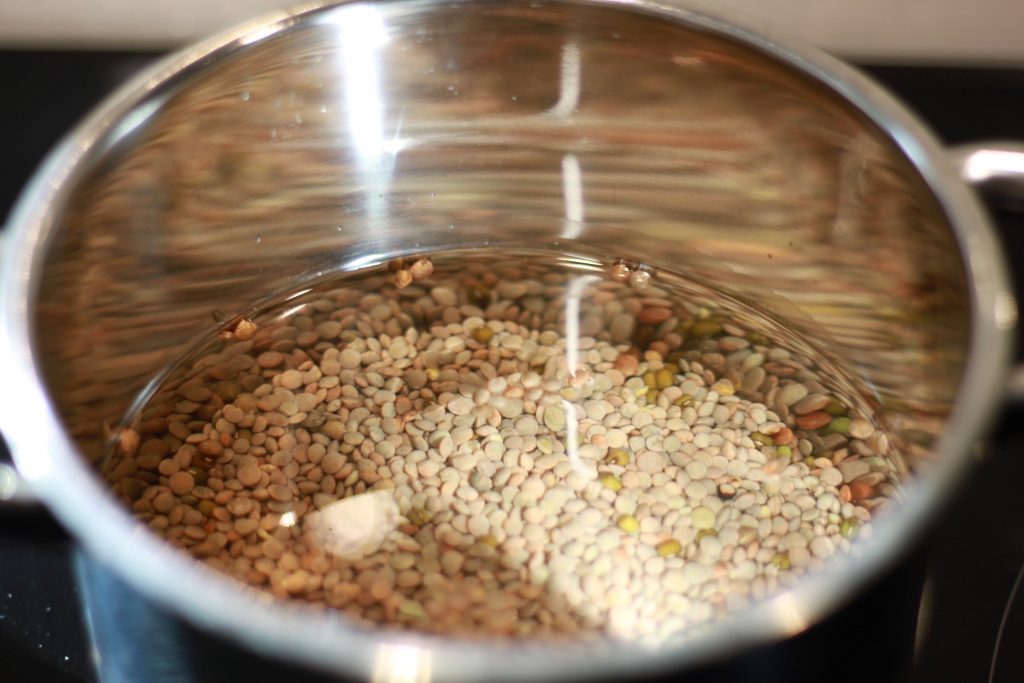
Soaking lentils and legumes is one way to improve bioavailability of iron and other nutrients.
Many studies have shown that common cooking and training methods such as fermenting, germinating and de-hulling legumes, and malting cereals can reduce phytate levels and, hence, increment iron bioavailability from these foods[39]. Phenolic compounds such every bit tannins and polyphenols, which are abundant in tea and coffee, also inhibit iron absorption. Avoiding drinking tea and coffee within two hours of consuming a repast rich in fe is recommended for individuals with low iron status[forty],[41],[42].
Nutrient-nutrient interactions tin also bear on bioavailability. For instance, calcium is another inhibitor of atomic number 26 bioavailability, due to contest for absorption across the intestinal wall. This is more oft observed when calcium and iron are part of the same meal and calcium quantity is high[43].
On the other hand, foods rich in vitamin C tin increase plant-based iron assimilation[44] considering this vitamin binds to non-haem iron to form a chelate that is soluble and digestible within the small intestine. However, it is important to note that cooking vitamin C-rich foods at a high temperature can destroy some of the vitamin C present in foods, reducing its ability to improve atomic number 26 assimilation[45],[46].
In that location is show to suggest individuals can maintain acceptable atomic number 26 stores without consuming animate being derived foods, provided effective planning of meals to reduce the presence of inhibitors and increase enhancers is applied[47],[48]. This approach takes careful management, and the prevalence of iron deficiency globally would propose fortification and supplementation are supported, especially for menstruating women[49].
Zinc
Zinc deficiency is prevalent globally, particularly for developing countries that consume a primarily plant-based nutrition[50]. This is mainly due to the low bioavailability of zinc in plant foods rather than a lack of plant zinc sources[51]. The EPIC-Oxford cohort reported that average zinc intakes of vegans were approximately 20% lower than non-vegetarians[52]. In this study, even non-vegetarians had zinc intakes that were below the RDA, suggesting that plant-based eaters might be at an even higher hazard of deficiency due to the low bioavailability of plant-based zinc[53]. However, the American Dietetic Association and Dietitians of Canada expressed no considerable business for vegetarians and inadequate zinc intakes in their position newspaper on vegetarian diets in 2003[54].
Institute-based zinc bioavailability
In research studies, zinc bioavailability from plant-based diets is oftentimes measured alongside iron. In full general, skilful quality found-based diets predominantly consist of whole grains and legumes, which are rich sources of zinc. Every bit with non-haem fe, phytic acid has a significant inhibitory effect on zinc absorption[55],[56]. However, processing methods that can increase the activeness of phytate degrading enzymes annul this considerably. Processes such every bit heating, formation, soaking, and fermentation of legumes and grains increment zinc bioavailability, provided the optimum pH is achieved. Enzymes for degrading phytates work all-time in an acidic pH surroundings for cereals and neutral or alkaline for some legumes[57]. The high fibre content in whole grains and legumes inhibit zinc assimilation simply preparation methods like de-hulling, force per unit area-cooking, and fermentation can breakup the fibre and enhance zinc bioavailability[58],[59].
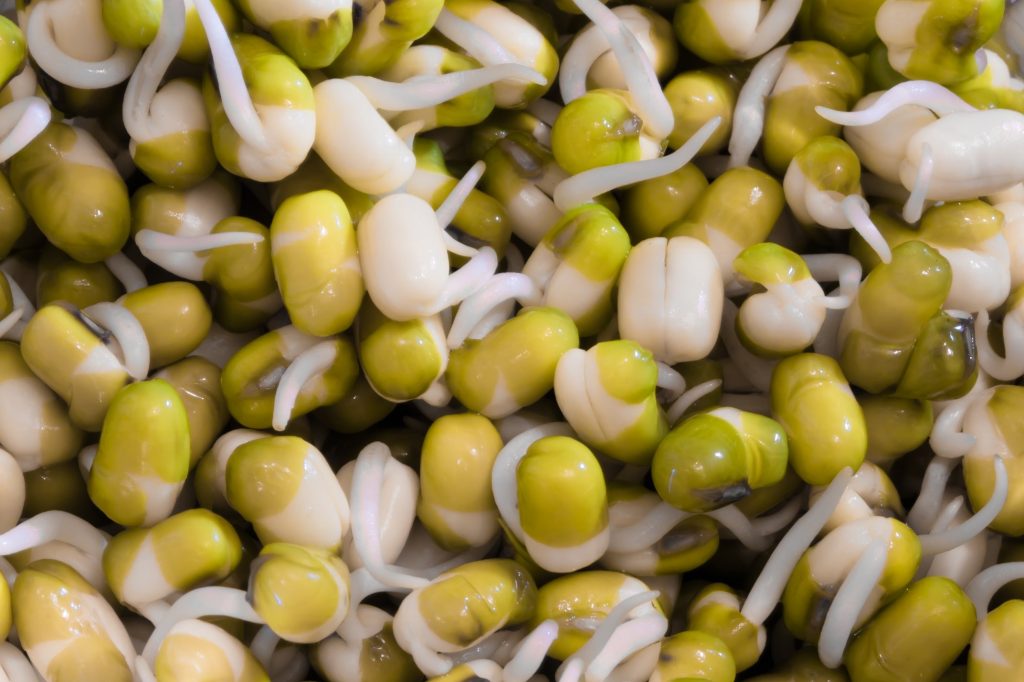
Sprouting or fermenting legumes can amend bioavailability of nutrients like zinc.
There are studies suggesting that consuming a meal that is both loftier in protein and zinc has a positive effect on zinc bioavailability[60],[61],[62]. Although bioavailability of zinc in establish-based diets is low, with prudent cooking and meal planning, it is possible to meet adequate body needs.
Vitamin B12
The main dietary sources of Vitamin B12 are products derived from ruminants, such as cows, considering microorganisms present in the digestive tracts of ruminants produce this nutrient[63]. Vitamin B12 is by and large non present in plant foods, but fortified breakfast cereals are a readily bachelor source of vitamin B12 with high bioavailability for vegetarians. This aligns with the EPIC-Oxford cohort ascertainment that on average vegans consumed approximately 93% less vitamin B12 than meat eaters[64]. However, inadequate vitamin B12 quantities in plant-based diets are widely acknowledged and individuals following a institute-based nutrition are advised to consume foods fortified with vitamin B12 and to have a supplement[65],[66],[67].
Vitamin B12 assimilation depends on ii compounds produced in the stomach: (i) a poly peptide called "intrinsic cistron" (IF) and (2) gastric acrid. The power of the stomach to produce these compounds functionality declines with age, thus the power to absorb vitamin B12 reduces over time[68].
Vitamin B12 is typically added to foods and supplements in its free class, meaning gastric acrid is not required to brand this type of vitamin B12 absorbable. However, the IF is at chapters at only ane-2 mcg vitamin B12, and absorption decreases considerably then[69]. Therefore, vitamin B12 is best absorbed in small quantities. To ensure adequate intake individuals post-obit a plant-based diet should eat vitamin B12 fortified foods on more than one occasion throughout the day[70].
Vitamin A
Sources of vitamin A
Vitamin A deficiency is a major issue in developing counties. There are two forms of vitamin A bachelor in the human diet; preformed vitamin A, for example retinol, and provitamin A carotenoids. Animal derived products such as liver, fish oils, milk, and eggs are rich in preformed vitamin A. Both provitamin A carotenoids and preformed vitamin A must be metabolised before utilize by the trunk[71]. The virtually abundant and efficiently converted carotenoid in plant-based diets is b-Carotene, and provides fruits and vegetables, such as mangos, oranges, carrots, and beetroot, with a yellow/orange/red color[72]. Conversion of b-Carotene to retinol is not very efficient in the torso; therefore, the daily requirement of b-Carotene is considerably higher than the RDA for vitamin A[73]. Hence, RDAs for vitamin A are given as retinol activity equivalents (RAE) to business relationship for the dissimilar bioactivities of retinol and provitamin A carotenoids. I mcg RAE is equivalent to ane mcg retinol and 12 mcg dietary beta-carotene[74].
Vitamin A bioavailability
However, a healthy plant-based diet is arable in fruit and vegetables that are rich in b-Carotene. Therefore, meeting the required corporeality is feasible[75], unless role of a population that depends on a staple nutrition of poor vitamin A source grain, such as rice. Cooking methods tin can increment the bioavailability of carotenoids, particularly heating in a little fatty/oil[76],[77] or adding acidulants or antioxidant spices such as lime, tamarind, onion or turmeric[78]. Although b-Carotene bioavailability is lower than vitamin A, this tin be overcome with a varied nutrition of fruit and vegetables and specific cooking processes.
Essential Fatty Acids
Omega-vi and Omega-3 fatty acids are both essential for the human body, significant they demand to exist consumed in the nutrition to support adequate amounts in the body. The long chain omega-iii fatty acids eicosapentaenoic acid (EPA) and docosahexaenoic acrid (DHA) are key nutrients for optimum wellness and development. They contribute to many functions in the body such as normal brain and eye evolution and maintenance of cardiovascular health[79]. Oily fish are the richest source of these fatty acids, while plant-based diets are low in these nutrients[eighty]. The current UK dietary recommendation for essential fatty acrid intake is to eat at least two portions of fish a calendar week, ane of which should exist oily[81]. For some individuals, fish may not be part of a found-based diet; therefore, levels of these fat acids are more often than not sub-optimal.
Plant-based sources of omega-3 fats
The trunk can convert a found sourced omega-3 fatty acid, a-linoleic acrid (ALA) to EPA and DHA, however the conversion efficacy is low[82]. Proficient quality institute-based diets are high in ALA. Rich sources include chia seeds, flaxseeds, hemp seeds, and rapeseed oil[83],[84]. However, bioavailability of ALA is reduced past the presence of the omega-6 fatty acid linoleic acid (LA), which is also abundant in plant-based foods. Sources of LA include sunflower oil, sesame oil, almonds, and cashews[85]. LA competes with ALA for enzymes needed to convert ALA to EPA and DHA[86]. Therefore, expert quality plant-based diets will aim to have a ratio of one:3 omega-6 to omega-3 fatty acids in the nutrition and avoid them within the same repast[87].
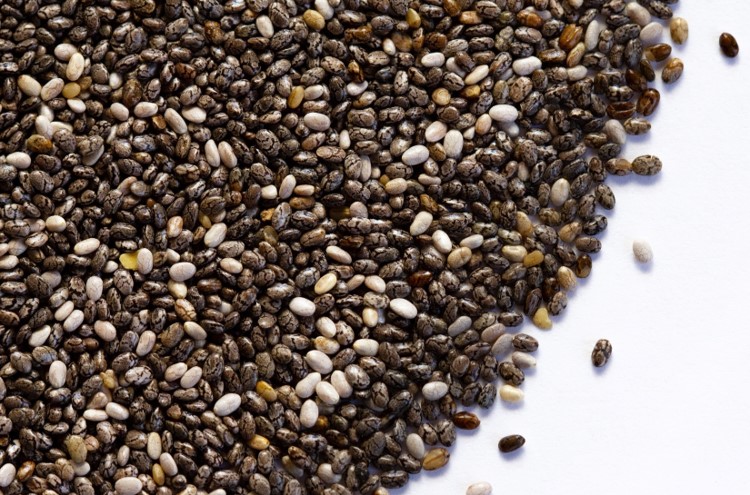
Chia seeds are a plant-based source of omega-3 fatty acids.
Poly peptide, calcium, biotin, magnesium and zinc can increase ALA bioavailability[88],[89], and a good quality institute-based diet is sufficient in these nutrients. Co-ordinate to the American Dietetic Clan, a sufficient intake of ALA in the nutrition is adequate to meet EPA and DHA needs; even so, if an private has increased needs or poor conversion and then a direct source such every bit DHA-rich microalgae is advised[90]. EPA and DHA supplementation is a controversial topic, as there were concerns regarding the rubber of over consumption, however the European Food Rubber Authority (EFSA) has concluded 5g of long-concatenation omega-3 fatty acids heighten no prophylactic concerns for adults[91].
Iodine
Iodine is an essential trace element imperative for brain development, normal growth and metabolism[92]. Plant foods can exist insufficient and unreliable iodine sources[93]. Acceptable iodine intake is a business organization for people who follow a plant-based diet. Iodised table salt policies were implemented in various countries across the world to eradicate deficiency. Nevertheless, recommendations to reduce salt intake to support centre health as well mean reducing iodine intake. Almost salt used in packaged foods is non iodised.
Iodine in plant-based diets
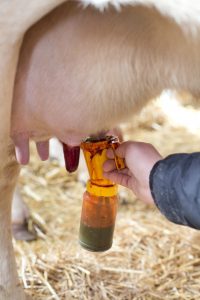
Dairy products are a main source of iodine in the nutrition considering iodine is used every bit a disinfectant in many dairy farms.
In the The states, Ireland, UK, and most of Europe, the main source of iodine is from milk and milk products, followed by fish and meat. The loftier content in milk is a consequence of iodine addition in moo-cow feed and iodine-containing disinfectants used during milking[94]. Therefore, it is of import to note that vegetarians who swap dairy milk to a establish-based alternative may be at risk of inadequate iodine intake. Furthermore, a study conducted by the University of Surrey reported that organic milk was 42% lower in iodine than conventional milk[95].
Seaweed is a very rich source of iodine, especially kelp. However, the iodine content can be likewise high, and excessive iodine intake can have negative health effects. For this reason, information technology is advised to limit seaweed consumption to once a calendar week, particularly if you are pregnant[96]. There is express research investigating the bioavailability of iodine in plant-based diets, although information technology appears to be high[97]. However, virtually literature papers investigating vegan diets highlight iodine as a nutrient at risk of inadequate intakes[98],[99],[100].
Summary of Bioavailability for Institute-based Nutrients
Conclusion
Establish sources of certain nutrients have a significantly lower quantity and bioavailability compared with creature derived foods. Many factors tin affect food bioavailability including the presence of anti-nutrients; cooking and processing methods; host factors; and nutrient-nutrient interactions. Bioavailability is an important gene when evaluating the quality of a diet because information technology has a substantial outcome on the amount of nutrients available to the body for of import functions. Therefore, rating foods and diets on nutrient quantities lone is not fully reflective of nutritional quality.
It is of import to notation that constitute-based diets can run into the nutritional needs of an private, provided they are good quality and supplemented with specific nutrients, if needed[101] [102].
References
[1] Ghavidel R A, Prakash J. The touch of germination and dehulling on nutrients, antinutrients, in vitro iron and calcium bioavailability and in vitro starch and protein digestibility of some legume seeds. LWT – Nutrient Scientific discipline and Engineering. 2007 Sep; forty(vii):1292-1299.
[2] The European Food Information Council (2010) 'Food bioavailability: Getting the near out of nutrient' https://www.eufic.org/en/food-today/article/nutrient-bioavailability-getting-the-well-nigh-out-of-nutrient. Accessed May 2020.
[3] Yang J, Punshon T, Guerinot M, et al. (2012) 'Plant Calcium Content: Ready to Remode.' Nutrients. 2012 Aug; 4(eight): 1120–1136. Published online 2012 Aug 21. doi: 10.3390/nu4081120
[4] Clarys P, Deliens T, Huybrechts I, et al. (2014) 'Comparison of nutritional quality of the vegan, vegetarian, semi-vegetarian, pesco-vegetarian and omnivorous diet.' Nutrients. 2014 Mar 24; half-dozen(three):1318-32.
[5] Messina V, Mangels AR. (2001) 'Considerations in planning vegan diets: children.' J Am Diet Assoc. 2001 Jun;101(six):661-9.
[6] Platel 1000, Srinivasan M. (2013) 'Bioavailability of Micronutrients from Plant Foods: An Update.' Crit Rev Food Sci Nutr. 2016 Jul 26;56(10):1608-19. doi: x.1080/10408398.2013.781011.
[seven] Davey GK, Spencer EA, Appleby PN, et al. (2003) 'Ballsy-Oxford: lifestyle characteristics and nutrient intakes in a cohort of 33 883 meat-eaters and 31 546 non meat-eaters in the UK.' Public Health Nutr. 2003 May;6(3):259-69.
[eight] Amalraj A, Pius A.(2015) 'Bioavailability of calcium and its assimilation inhibitors in raw and cooked light-green leafy vegetables commonly consumed in India – An in vitro written report.' Food Chemistry. (2015) Mar 1;170:430-6. doi: 10.1016/j.foodchem.2014.08.031. Epub 2014 Aug 27.
[9] Noonan SC, Brutal GP. (1999) 'Oxalate content of foods and its outcome on humans.' Asia Pacific J Clin Nutr. (1999) 8(1): 64-74
[10] Yang, Jian et al. "Institute calcium content: ready to remodel." Nutrients vol. 4,eight (2012): 1120-36. doi:10.3390/nu4081120
[11] Cockwell KA. Calcium. Elsevier Scientific discipline Ltd., 2003.
[12] Ghavidel R A, Prakash J. The touch on of germination and dehulling on nutrients, antinutrients, in vitro atomic number 26 and calcium bioavailability and in vitro starch and protein digestibility of some legume seeds. LWT – Food Science and Technology. 2007 Sep; 40(7):1292-1299.
[13] Hambidge KM, Krebs NF, Westcott JL, et al. (2005) 'Absorption of calcium from tortilla meals prepared from low-phytate maize.' Am J Clin Nutr. 2005 Jul;82(1):84-seven.
[14] Ghavidel R A, Prakash J. The affect of germination and dehulling on nutrients, antinutrients, in vitro atomic number 26 and calcium bioavailability and in vitro starch and poly peptide digestibility of some legume seeds. LWT – Nutrient Science and Technology. 2007 Sep; twoscore(seven):1292-1299.
[fifteen] Caroli A et al. (2011) 'Invited review: Dairy intake and bone health: A viewpoint from the state of the art.' J Dairy Sci 2011;94(11):5249-62.
[sixteen] Craig WJ. (2009) 'Health effects of vegan diets.' Am J Clin Nutr. 2009;89(5):1627S–1633S. doi: ten.3945/ajcn.2009.26736N.
[17] American Dietetic Association; Dietitians of Canada. (2003) 'Position of the American Dietetic Association and Dietitians of Canada: Vegetarian diets.' J Am Diet Assoc. 2003 Jun;103(6):748-65.
[eighteen] Lonnie, Marta et al. "Poly peptide for Life: Review of Optimal Protein Intake, Sustainable Dietary Sources and the Outcome on Appetite in Ageing Adults." Nutrients vol. 10,3 360. xvi Mar. 2018, doi:10.3390/nu10030360
[19] American Guild for Nutrition. (2011) "Customs and Public Wellness Nutrition; Protein Complementation". https://diet.org/protein-complementation/. Accessed May 2020.
[20] American Dietetic Association; Dietitians of Canada. (2003) 'Position of the American Dietetic Association and Dietitians of Canada: Vegetarian diets.' J Am Diet Assoc. 2003 Jun;103(6):748-65.
[21] De Gavelle, Erwan et al. "Poly peptide Adequacy Is Primarily a Matter of Protein Quantity, Non Quality: Modeling an Increase in Plant:Animal Protein Ratio in French Adults."Nutrients vol. 9,12 1333. 8 Dec. 2017, doi:ten.3390/nu9121333
[22] American Society for Nutrition. (2011) "Customs and Public Health Nutrition; Protein Complementation". https://nutrition.org/poly peptide-complementation/. Accessed May 2020.
[23] Jonnalagadda S. Matthews O. (2020) 'Nutritional Benefits of Plant Proteins Taking Root with Consumers'. Kerry health and Nutrition Institute. https://khni.kerry.com/news/blog/nutritional-benefits-of-plant-proteins-taking-root-with-consumers/. Accessed: May 2020.
[24] Trang HM, Cole DE, Rubin LA, et al. (1998) Evidence that vitamin D3 increases serum 25-hydroxyvitamin D more efficiently than does vitamin D2. Am J Clin Nutr. 1998 October;68(iv):854-8.
[25] Nair, R., & Maseeh, A. (2012). Vitamin D: The "sunshine" vitamin. Journal of pharmacology & pharmacotherapeutics, 3(2), 118–126. https://doi.org/10.4103/0976-500X.95506
[26] NHS. (2020) 'Vitamins and Minerals; Vitamin D' https://world wide web.nhs.uk/conditions/vitamins-and-minerals/vitamin-d/. Accessed: May 2020
[27] Davey GK, Spencer EA, Appleby PN, et al. (2003) 'EPIC-Oxford: lifestyle characteristics and nutrient intakes in a cohort of 33 883 meat-eaters and 31 546 non meat-eaters in the UK.' Public Health Nutr. 2003 May;6(3):259-69.
[28] Cashman, Kevin D et al. "Vitamin D deficiency in Europe: pandemic?." The American periodical of clinical nutrition vol. 103,four (2016): 1033-44. doi:x.3945/ajcn.115.120873
[29] British Nutrition Foundation. (2020) 'New advice on Vitamin D.' British Diet Foundation website. https://www.nutrition.org.united kingdom/nutritioninthenews/new-reports/983-newvitamind.html. Accessed: May 2020.
[30] The Scientific Advisory Committee on Diet (SACN) (2016) 'Vitamin D and Wellness'. https://avails.publishing.service.gov.britain/government/uploads/system/uploads/attachment_data/file/537616/SACN_Vitamin_D_and_Health_report.pdf. Accessed: May 2020.
[31] NHS. (2020) 'Vitamins and Minerals; Vitamin D' https://www.nhs.uk/conditions/vitamins-and-minerals/vitamin-d/. Accessed: May 2020
[32] De Benoist, Hempstead R. (2001). 'Atomic number 26 Deficiency Anaemia Assessment, Prevention and Control A guide for programme managers' World Wellness Organisation' 2001 five(15).
[33] West, A. R., & Oates, P. Southward. (2008). Mechanisms of heme iron absorption: current questions and controversies.Earth periodical of gastroenterology, xiv(26), 4101–4110. https://doi.org/10.3748/wjg.14.4101
[34] Young, I., Parker, H. M., Rangan, A., et al. (2018). 'Association between Haem and Non-Haem Iron Intake and Serum Ferritin in Good for you Young Women.' Nutrients, 10(one), 81. https://doi.org/10.3390/nu10010081
[35] American Dietetic Association; Dietitians of Canada. (2003) 'Position of the American Dietetic Association and Dietitians of Canada: Vegetarian diets.' J Am Diet Assoc. 2003 Jun;103(6):748-65.
[36] Sandberg AS. (2002) Bioavailability of minerals in legumes.Br J Nutr. 2002 Dec;88 Suppl three:S281-5.
[37] Gupta, Raj Kishor et al. (2015) "Reduction of phytic acid and enhancement of bioavailable micronutrients in food grains." Journal of nutrient science and technology 2015;52(2):676‐684. doi:10.1007/s13197-013-0978-y
[38] Sandberg As. (2002) Bioavailability of minerals in legumes.Br J Nutr. 2002 Dec;88 Suppl 3:S281-5.
[39] Gibson RS, Perlas L, Hotz C. (2006) Improving the bioavailability of nutrients in establish foods at the household level. Proceedings of the Diet Society (2006), 65, 160–168 Proceedings of the Diet Society (2006), 65, 160–168 DOI:ten.1079/PNS2006489
[40] De Benoist, Hempstead R. (2001). 'Fe Deficiency Anaemia Assessment, Prevention and Control A guide for programme managers' World Health Organisation' 2001 8(66).
[41] Janet R, Hunt Am. (2003) 'Bioavailability of iron, zinc, and other trace minerals from
vegetarian diet.' J Clin Nutr 2003;78(suppl):633S–9S
[42] Delimont NM, Haub MD, Lindshield BL. (2017) 'The Impact of Tannin Consumption on Fe Bioavailability and Status: A Narrative Review.' Curr Dev Nutr. 2017 Feb; ane(two): one–12. Published online 2017 Jan 19. doi: 10.3945/cdn.116.000042
[43] Hallberg L, Rossander-Hultén Fifty, Brune 1000, Gleerup A. (1992) 'Calcium and iron assimilation: machinery of activeness and nutritional importance.' Eur J Clin Nutr. 1992;46(5):317‐327
[44] Purushothaman Five, M A, Tsou SC, South S. Supplementing atomic number 26 bioavailability enhanced mung bean. Asia Pac J Clin Nutr. 2008;17 Suppl 1:99-102.
[45] Teucher B, Olivares M, Cori H. (2004) 'Enhancers of fe absorption: ascorbic acid and other organic acids.' Int J Vitam Nutr Res. 2004;74(half-dozen):403‐419. doi:ten.1024/0300-9831.74.6.403
[46] Lynch SR, Cook JD. (1980) 'Interaction of vitamin C and iron.' Ann N Y Acad Sci. 1980;355:32‐44. doi:10.1111/j.1749-6632.1980.tb21325.x
[47] Young, I., Parker, H. M., Rangan, A., et al. (2018). 'Clan between Haem and Not-Haem Iron Intake and Serum Ferritin in Salubrious Young Women.' Nutrients, 10(1), 81. https://doi.org/10.3390/nu10010081
[48] Anderson BM, Gibson RS, Sabry JH. (1981) 'The iron and zinc status of long-term vegetarian women.' Am J Clin Nutr. 1981 Jun;34(6):1042-8
[49] De Benoist, Hempstead R. (2001). 'Iron Deficiency Anaemia Cess, Prevention and Control A guide for program managers' World Health Organisation' 2001 8(66).
[50]IZiNCG Secretariat. UCSF Benioff Children's Hospital Oakland. (2019) 'ESTIMATING NATIONAL RISK OF ZINC DEFICIENCY: PROXY INDICATORS VS. PLASMA/SERUM ZINC CONCENTRATIONS'. https://www.izincg.org/new-blog-1/estimating-national-hazard-of-zinc-deficiency
[51] Platel Thou, Srinivasan K. (2016) 'Bioavailability of Micronutrients from Plant Foods: An Update.' Crit Rev Food Sci Nutr. 2016 Jul 26;56(10):1608-xix. doi: 10.1080/10408398.2013.781011.
[52] Davey GK, Spencer EA, Appleby PN, et al. (2003) 'Ballsy-Oxford: lifestyle characteristics and nutrient intakes in a accomplice of 33 883 meat-eaters and 31 546 non meat-eaters in the UK.' Public Health Nutr. 2003 May;6(3):259-69.
[53] Davey GK, Spencer EA, Appleby PN, et al. (2003) 'Epic-Oxford: lifestyle characteristics and nutrient intakes in a cohort of 33 883 meat-eaters and 31 546 not meat-eaters in the UK.' Public Health Nutr. 2003 May;vi(3):259-69.
[54] American Dietetic Clan; Dietitians of Canada. (2003) 'Position of the American Dietetic Clan and Dietitians of Canada: Vegetarian diets.' J Am Diet Assoc. 2003 Jun;103(six):748-65.
[55] Janet R, Hunt Am. (203) 'Bioavailability of iron, zinc, and other trace minerals from
vegetarian nutrition.' J Clin Nutr 2003;78(suppl):633S–9S
[56] Fredlund 1000, Isaksson M, Rossander-Hulthén L, et al. (2006) 'Absorption of zinc and retention of calcium: dose-dependent inhibition by phytate.' J Trace Elem Med Biol. 2006;twenty(1):49-57. Epub 2006 Mar two.
[57] Sandberg As. (2002) Bioavailability of minerals in legumes.Br J Nutr. 2002 Dec;88 Suppl three:S281-v.
[58] Hemalatha, South., Platel, K. and Srinivasan, K. (2007). 'Zinc and iron content and their bioaccessibility in cereals and pulses consumed in India.' Food Chem. 102:1328–1336.
[59] Suliburska, J., & Krejpcio, Z. (2014). Evaluation of the content and bioaccessibility of iron, zinc, calcium and magnesium from groats, rice, leguminous grains and nuts.Journal of food science and engineering science, 51(3), 589–594. https://doi.org/ten.1007/s13197-011-0535-5
[60] Dietary factors influencing zinc absorption. J Nutr. 2000 May;130(5S Suppl):1378S-83S. doi: 10.1093/jn/130.v.1378S.
[61] Platel Thou, Srinivasan M. (2016) 'Bioavailability of Micronutrients from Found Foods: An Update.' Crit Rev Food Sci Nutr. 2016 Jul 26;56(10):1608-19. doi: 10.1080/10408398.2013.781011.
[62] Janet R, Hunt Am. (2003) 'Bioavailability of iron, zinc, and other trace minerals from vegetarian nutrition.' J Clin Nutr 2003;78(suppl):633S–9S
[63] Rogerson D. (2017) 'Vegan diets: applied advice for athletes and exercisers.' J Int Soc Sports Nutr. 2017; 14: 36. Published online 2017 Sep 13. doi: x.1186/s12970-017-0192-
[64] Davey GK, Spencer EA, Appleby PN, et al. (2003) 'EPIC-Oxford: lifestyle characteristics and nutrient intakes in a cohort of 33 883 meat-eaters and 31 546 not meat-eaters in the UK.' Public Health Nutr. 2003 May;six(3):259-69.
[65] Davey GK, Spencer EA, Appleby PN, et al. (2003) 'EPIC-Oxford: lifestyle characteristics and nutrient intakes in a cohort of 33 883 meat-eaters and 31 546 non meat-eaters in the U.k..' Public Health Nutr. 2003 May;6(3):259-69.
[66] Messina Five, Mangels AR. (2001) 'Considerations in planning vegan diets: children.' J Am Nutrition Assoc. 2001 Jun;101(6):661-9.
[67] Craig WJ. (2009) 'Health effects of vegan diets.' Am J Clin Nutr. 2009;89(five):1627S–1633S. doi: x.3945/ajcn.2009.26736N.
[68] Agnoli C, Baroni L, Bertini I, et al. (2017) 'Position paper on vegetarian diets from the working group of the Italian Gild of Homo Nutrition.' Nutr Metab Cardiovasc Dis. 2017 Dec;27(12):1037-1052. doi: 10.1016/j.numecd.2017.10.020. Epub 2017 Oct 31.
[69] Role of Dietary Supplements (February 2020) 'Vitamin B12; Fact Sheet for Consumers' U.South. Department of Health & Human Services; National Institutes of Wellness: https://ods.od.nih.gov/pdf/factsheets/VitaminB12-Consumer.pdf
[seventy] British Dietetic Clan (2017) 'Plant-based diet: Food Fact Sheet'. https://www.bda.uk.com/resource/plant-based-diet.html. Accessed: May 2020.
[71] Role of Dietary Supplements (March 2020) 'Vitamin A; Fact Sheet for Wellness Professionals' U.Southward. Department of Health & Human being Services; National Institutes of Wellness:https://ods.od.nih.gov/factsheets/VitaminA-HealthProfessional/#h3. Accessed on: May 2020.
[72] Platel K, Srinivasan M. (2013) 'Bioavailability of Micronutrients from Plant Foods: An Update.' Crit Rev Food Sci Nutr. 2016 Jul 26;56(x):1608-19. doi: x.1080/10408398.2013.781011.
[73] Platel Grand, Srinivasan K. (2013) 'Bioavailability of Micronutrients from Plant Foods: An Update.' Crit Rev Food Sci Nutr. 2016 Jul 26;56(ten):1608-19. doi: 10.1080/10408398.2013.781011.
[74] Office of Dietary Supplements (March 2020) 'Vitamin A; Fact Canvass for Health Professionals' U.S. Section of Wellness & Human Services; National Institutes of Health:https://ods.od.nih.gov/factsheets/VitaminA-HealthProfessional/#h3. Accessed on: May 2020.
[75] American Dietetic Association; Dietitians of Canada. (2003) 'Position of the American Dietetic Association and Dietitians of Canada: Vegetarian diets.' J Am Diet Assoc. 2003 Jun;103(6):748-65.
[76] American Dietetic Association; Dietitians of Canada. (2003) 'Position of the American Dietetic Association and Dietitians of Canada: Vegetarian diets.' J Am Diet Assoc. 2003 Jun;103(6):748-65.
[77] Nair Thousand Grand, Augustine LF. (2018) 'Nutrient synergies for improving bioavailability of micronutrients from
plant foods'. Food Chemistry. 2018. 238:180–185.
[78] Veda S, Platel G, Srinivasan M.J.(2008) 'Influence of nutrient acidulants and antioxidant spices on the bioaccessibility of beta-carotene from selected vegetables.' Agric Food Chem. 2008 Sep 24;56(18):8714-ix. doi: 10.1021/jf801374d. Epub 2008 Aug 27.
[79]European Food Safety Say-so (2020) 'EU Register on nutrition and wellness claims.' https://ec.europa.eu/food/safety/labelling_nutrition/claims/register/public/?outcome=search. Accessed May 2020.
[80] Agnoli C, Baroni L, Bertini I, et al. (2017) 'Position paper on vegetarian diets from the working grouping of the Italian Society of Homo Nutrition.' Nutr Metab Cardiovasc Dis. 2017 Dec;27(12):1037-1052. doi: 10.1016/j.numecd.2017.10.020. Epub 2017 Oct 31.
[81] British Nutrition Foundation (2018) 'The Eatwell Guide – A revised good for you eating model'. https://www.nutrition.org.britain/healthyliving/healthydiet/eatwell.html. Accessed May 2020.
[82] Rogerson D. (2017) 'Vegan diets: practical advice for athletes and exercisers.' J Int Soc Sports Nutr. 2017; 14: 36. Published online 2017 Sep 13. doi: 10.1186/s12970-017-0192-
[83] Agnoli C, Baroni Fifty, Bertini I; et al. (2017) 'Diet, Metabolism & Cardiovascular Diseases Position paper on vegetarian diets from the working group of the Italian Guild of Human Nutrition.' Nutr. Metab. Cardiovasc. Dis. 2017, 27, 1037–1052.
[84] Welch A, Shakya-Shrestha S, Lentjes Grand, et al. (2010) 'Dietary intake and status of due north-3 polyunsaturated fatty acids in a population of fish-eating and not fish-eating meat-eaters, vegetarians, and vegans and the forerunner-product ratio of a-linolenic acrid to long-chain northward-3 polyunsaturated fatty acids: Results from the Epic-Norfolk cohort.' Am. J. Clin. Nutr. 2010, 92, 1040–1051
[85] Whelan, Jay, and Kevin Fritsche. (2013) "Linoleic acid." Advances in nutrition (Bethesda, Physician.) vol. four,3 311-2. 1 May. 2013, doi:10.3945/an.113.003772
[86] Cholewski, Mateusz et al. (2018) "A Comprehensive Review of Chemistry, Sources and Bioavailability of Omega-iii Fatty Acids."Nutrients vol. x,11 1662. 4 Nov. 2018, doi:10.3390/nu10111662
[87] Welch A, Shakya-Shrestha S, Lentjes K, et al. (2010) 'Dietary intake and status of n-three polyunsaturated fatty acids in a population of fish-eating and non fish-eating meat-eaters, vegetarians, and vegans and the precursor-product ratio of a-linolenic acid to long-chain n-3 polyunsaturated fatty acids: Results from the Ballsy-Norfolk cohort.' Am. J. Clin. Nutr. 2010, 92, 1040–1051
[88] Welch A, Shakya-Shrestha Southward, Lentjes M, et al. (2010) 'Dietary intake and status of due north-3 polyunsaturated fatty acids in a population of fish-eating and non fish-eating meat-eaters, vegetarians, and vegans and the precursor-product ratio of a-linolenic acid to long-chain n-iii polyunsaturated fatty acids: Results from the Ballsy-Norfolk cohort.' Am. J. Clin. Nutr. 2010, 92, 1040–1051
[89] Rogerson D. (2017) 'Vegan diets: practical advice for athletes and exercisers.' J Int Soc Sports Nutr. 2017; 14: 36. Published online 2017 Sep xiii. doi: 10.1186/s12970-017-0192-
[90] American Dietetic Association; Dietitians of Canada. (2003) 'Position of the American Dietetic Clan and Dietitians of Canada: Vegetarian diets.' J Am Diet Assoc. 2003 Jun;103(6):748-65.
[91] European Nutrient Safety Potency (2012) 'EFSA assesses safety of long-concatenation omega-3 fat acids'. https://www.efsa.europa.european union/en/press/news/120727. July 2012.
[92] British Dietetic Clan (2019) 'Iodine: Food Fact Sheet'. https://www.bda.united kingdom.com/resources/iodine.html Accessed: May 2020
[93] Rogerson D. (2017) 'Vegan diets: practical advice for athletes and exercisers.' J Int Soc Sports Nutr. 2017; 14: 36. Published online 2017 Sep thirteen. doi: 10.1186/s12970-017-0192
[94] Van der Reijden O L, Zimmermann Thou B, Galetti 5. (2017) 'Iodine in dairy milk: Sources, concentrations and importance to man health.' Best Exercise & Inquiry Clinical Endocrinology & Metabolism. 2017; 31(four)385-395.
[95] Bathroom, S., Button, S., & Rayman, Yard. (2012). 'Iodine concentration of organic and conventional milk: Implications for iodine intake.' British Periodical of Nutrition, 107(vii), 935-940. doi:10.1017/S0007114511003059
[96] British Dietetic Association (2019) 'Iodine: Food Fact Sheet'. https://www.bda.uk.com/resource/iodine.html Accessed: May 2020
[97] Platel Yard, Srinivasan K. (2013) 'Bioavailability of Micronutrients from Institute Foods: An Update.' Crit Rev Food Sci Nutr. 2016 Jul 26;56(10):1608-19. doi: x.1080/10408398.2013.781011.
[98] Rogerson D. (2017) 'Vegan diets: practical advice for athletes and exercisers.' J Int Soc Sports Nutr. 2017; 14: 36. Published online 2017 Sep 13. doi: 10.1186/s12970-017-0192
[99] Sebastiani G, Barbero A H, Borrás-Novell C, et al. (2019) 'The Furnishings of Vegetarian and Vegan Diet during Pregnancy on the Health of Mothers and Offspring.' Nutrients. 2019;11(three):557. Published 2019 Mar half dozen. doi:10.3390/nu11030557
[100] American Dietetic Association; Dietitians of Canada. (2003) 'Position of the American Dietetic Association and Dietitians of Canada: Vegetarian diets.' J Am Nutrition Assoc. 2003 Jun;103(6):748-65.
[101] Agnoli C, Baroni Fifty, Bertini I, et al. (2017) 'Position newspaper on vegetarian diets from the working grouping of the Italian Society of Homo Nutrition.' Nutr Metab Cardiovasc Dis. 2017 December;27(12):1037-1052. doi: 10.1016/j.numecd.2017.10.020. Epub 2017 Oct 31.
[102] American Dietetic Association; Dietitians of Canada. (2003) 'Position of the American Dietetic Association and Dietitians of Canada: Vegetarian diets.' J Am Diet Assoc. 2003 Jun;103(6):748-65.
- Pattie O'Keeffe, BSc, ANutr
Pattie O'Keeffe, BSc ANutr is a Nutrition graduate from University College Cork. Pattie joined Kerry Grouping in 2016 and worked inside Regulatory Diplomacy. In 2019, Pattie became of the Kerry Nutrition Science team where she provides her expertise to all areas of the business.
Source: https://khni.kerry.com/news/nutrition-for-plant-based-diets-managing-nutrient-intake-and-bioavailability/
Posted by: mercierwhitu1954.blogspot.com

0 Response to "Does Bioavailability Change Between Animal And Plant Sources?"
Post a Comment